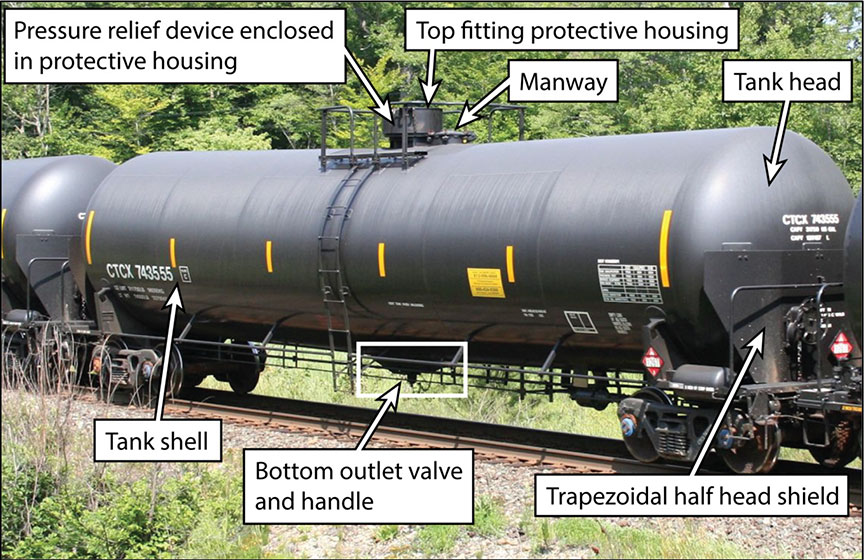Information about tank cars that carry flammable liquids
The occurrence
On 7 March 2015, a Canadian National Railway (CN) unit train equipped with 2 head-end locomotives hauling 94 Class 111 tank cars loaded with crude oil (Class 3 flammable liquids) was proceeding eastward on CN's Ruel Subdivision near Gogama, Ontario. The train was 5733 feet long and weighed 13,497 tons. The Class 111 tank cars were built to the CPC-1232 standard (see Figure 1).
Early in the morning, while travelling at 43 mph, the train crew experienced a train-initiated emergency brake application at Mile 88.70, the crew observed a large explosion and ensuing fire. After the train came to a stop, the crew disconnected the locomotives and the first 5 cars and travelled to a safe location east of the fire.
Of the 39 derailed tank cars, 33 had been breached and released product, fuelling the fire, and some product entered the river. The fire occupied an area about 300 yards in diameter and was centred near the west end of the rail bridge. As a result of the derailment, about 2.6 million litres of petroleum crude oil (UN1267) were released to atmosphere, water, or surface.
The occurrence train was designated as a "Key Train" operating on a "Key Route".
A "key train" is a train that includes:
- one or more tank cars of dangerous goods loaded with either toxic gases (Class 2.3 Transportation of Dangerous Goods (TDG) Regulations) or products that are toxic by inhalation (Special Provision 23 of the TDG Regs); or
- any combination of 20 or more loaded tank cars and/or intermodal portable tanks containing dangerous goods, as defined in the Transportation of Dangerous Goods Act, 1992.
A "key route" is:
- any track on which, over a period of one year, a railway carries any combination of 10,000 or more loaded tank cars or loaded intermodal portable tanks containing dangerous goods.
Standards for tank cars used in the transportation of Class 3 flammable liquids
The following table outlines the features of the standards for Class 111 and TC-117 tank cars used for the transportation of Class 3 flammable liquids:
| Requirements | Older legacy Class 111Note de bas de page 1 | Class 111 CPC 1232 compliant | New TC/DOT 117Note de bas de page 2 | |
|---|---|---|---|---|
| Non-jacketed and non-insulated | Jacketed and insulated | |||
| Head shields | No | Half | Full | Full |
| Top-fitting protection | Optional | Mandatory | Mandatory | Mandatory |
| Thermal protection and jacketed | Optional | Optional | Optional | Mandatory |
| Normalized steelNote de bas de page 3 | Optional | Mandatory | Mandatory | Mandatory |
| Thickness and type of steel (minimum) | 11.1 mm (7/16 inch) | 12.7 mm (1/2 inch) in TC128-B or 15.9 mm (5/8 inch) in ASTM A516-70 | 11.1 mm (7/16 inch) thick TC128-B or 12.7 mm (1/2 inch) in ASTM A516-70 |
14.3 mm thick (9/16 inch) in TC128-B |
| Performance standards for thermal protection, head and shell puncture resistance | No | No | No | Yes |
| Enhanced performance standard for bottom outlet valves | No | No | No | Yes |
